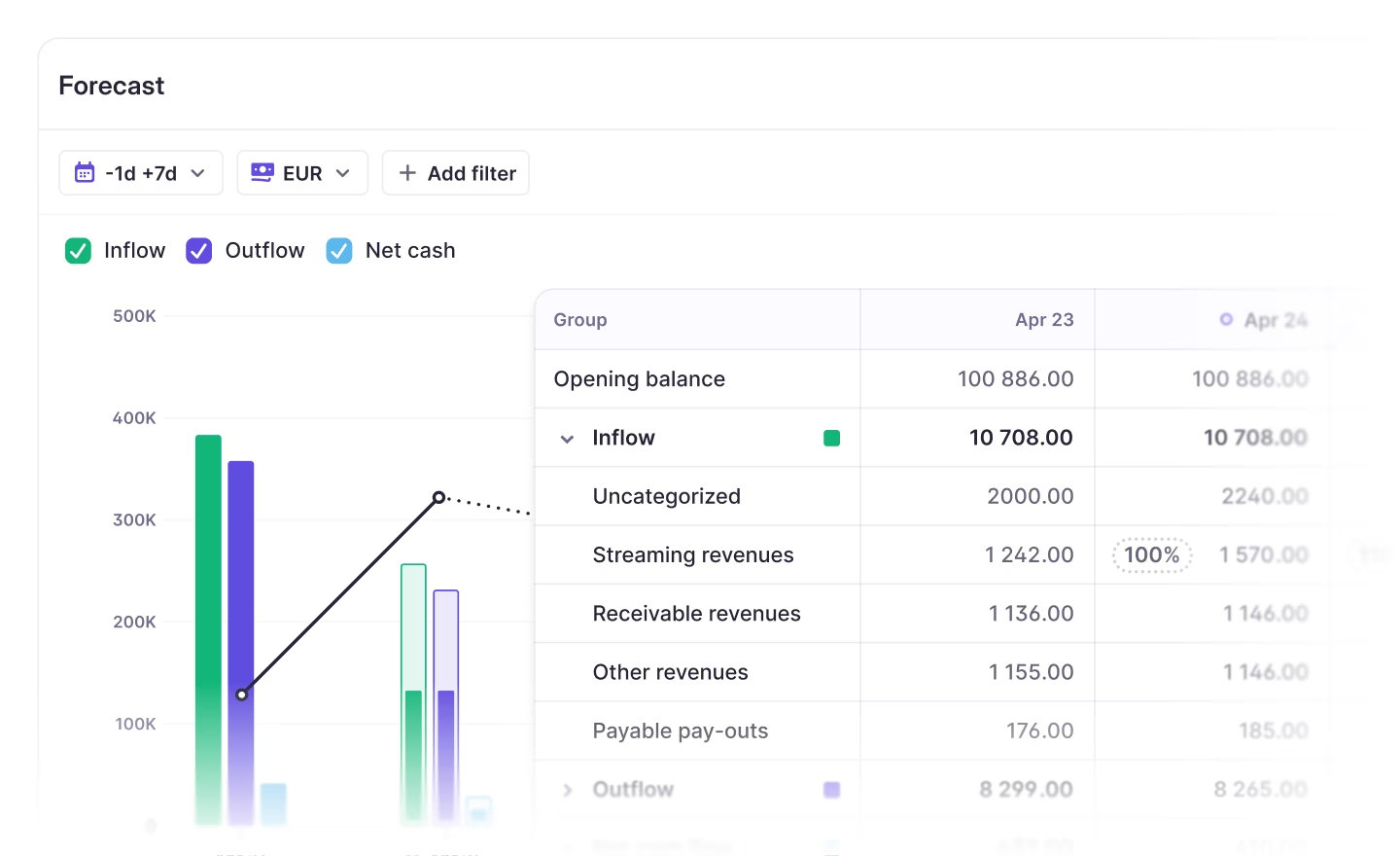What is the 13-week cash flow forecast?
The 13-week cash flow forecast is the most popular short-term forecast, projecting inflows and outflows over a 13-week period using the direct method.

Introduction to the 13-week cash flow forecast
The 13-week cash flow forecast is the most widely used type of short-term forecast. While longer term forecasts project a company’s cash flow over a period of six months to five years, the 13-week forecast focuses on the cash you have, the cash you expect to receive, and the cash you expect to pay out of your business over a 13-week period. Below is an example of this in the Atlar dashboard.
To learn more, read our in-depth guide to setting up a 13-week cash flow forecast.

Key characteristics of a 13-week cash flow forecast
Quarterly time horizon with weekly detail
The 13-week timeframe covers one fiscal quarter, giving you a manageable yet comprehensive view on cash flow that extends to the next key reporting date or quarter-end. Consisting of weekly periods, it also allows for close tracking of specific inflows and outflows—helping to capture payment cycles, seasonal patterns, and other short-term fluctuations in cash.
Direct forecasting method
Most 13-week forecasts use the “direct" forecasting method, tracking actual cash receipts and payments for transactions that have occurred or are expected to occur. This approach provides a real-time view of cash activity, which is crucial for day-to-day liquidity management. By contrast, longer term forecasts often use the “indirect” method, meaning that they rely on indirect adjustments from net income.
For example, a company’s forecasted cash flow statement—often included as part of its quarterly or annual budget or business plan—is derived indirectly from the forecasted income statement and balance sheet. Unlike the 13-week forecast, it’s intended to show the broad categories of where cash is generated and spent over a longer timeframe.
Non-cash items excluded
Another key difference between the 13-week forecast and other, longer term forecasts is that it doesn’t include non-cash accounting items such as depreciation and accruals for various expenses. Rather, it’s designed to precisely capture specific inflows and outflows of cash.
Forecast frequency and updates
Long-term forecasts, such as those covering six months or more, are typically created on a one-off basis—either quarterly or annually—and are intended to support long-term planning. In contrast, a 13-week forecast is used for short- to medium-term planning and is often updated weekly.
A rolling 13-week forecast is widely considered best practice over a static forecast because it provides greater accuracy and real-time visibility into cash inflow and outflow trends. Unlike a static forecast, a rolling forecast is continuously updated with new data, rather than relying on fixed, unchanging information. Although rolling forecasts require more maintenance, automating data collection can greatly reduce the workload.
Why is a 13-week time horizon useful?
A universal truth of forecasting is that accuracy degrades as forecast range increases. Most companies use a 13-week time horizon for regular cash flow forecasting because it strikes a good balance between accuracy and range. In any case, your time horizon should always be chosen intentionally based on business objectives—it determines the range and depth of information you can feasibly uncover from your forecast, whether that’s daily payments, weekly cash receipts, or quarterly sales trends.
Here are some of the key reasons that companies tend to use a 13-week time horizon for their cash flow forecasts.
Reliable and Accurate Insights
The 13-week model offers reliability by leveraging historical data and anticipated transactions to project near-term cash flow. While shorter-term forecasts, like week-to-week models, excel in immediacy, the 13-week horizon provides a medium-term perspective, making it ideal for cash planning and strategic decision-making.
Granular detail for better control
This forecasting model typically breaks down data into weekly reporting periods rather than lumping weeks together. Some tools can even deliver daily or transaction-level insights within the 13-week framework. This granularity allows finance and treasury teams to align forecasts with daily operations, such as scheduling supplier payments, managing debt drawdowns, planning loan repayments, or making investment decisions.
Proactive liquidity risk management
With week-by-week liquidity visibility, a 13-week forecast enables companies to identify potential medium-term liquidity risks with precision. This timeframe is often sufficient to address cash shortfalls through measures such as securing external financing or arranging inter-company loans, providing actionable insights to mitigate risks.
Alignment with reporting and planning cycles
The detailed nature of 13-week forecasts makes them a trusted measure of financial health and creditworthiness. Management teams, creditors, investors, and regulators frequently rely on these forecasts for regular reporting, whether monthly, quarterly, or annually. Covering a full quarter, the 13-week horizon naturally aligns with key reporting dates and planning cycles, including quarter-end reviews.
Furthermore, the weekly structure of a 13-week forecast offers greater granularity than traditional monthly financial plans. This prevents short-term planning gaps by capturing daily or weekly trends that might otherwise be missed, ensuring a more comprehensive view of cash flow dynamics.
When is a 13-week time horizon not recommended?
While widely used, 13-week forecasts aren’t universally applicable. The suitability of a forecast model depends on your company’s objectives and business model. Some organizations also adopt hybrid approaches, such as updating 13-week forecasts weekly while maintaining separate 6-month forecasts updated on a monthly basis.
Short-term liquidity planning
For businesses prioritizing immediate cash flow management, shorter forecasting horizons may be more effective. Models spanning 10 to 15 business days are ideal for companies focused on managing lines of credit, high-interest rates, or significant liabilities. These short-term forecasts provide the granular detail necessary to promptly settle debts, tightly control cash flow, and plan near-term expenditures.
Long-Term Liquidity Risk Management
To address longer-term cash flow needs, a 6-month forecast can be a better fit. This model often combines weekly projections for the first 13 weeks with monthly projections for the remaining 3 months. This approach allows businesses to identify liquidity risks farther into the future, ensuring sufficient cash reserves for strategic initiatives such as expansions or large investments.
Key steps to build a 13-week cash flow forecast
A 13-week cash flow forecast is an invaluable tool for financial planning and analysis, but building and maintaining it can be resource-intensive—especially if data collection is manual. While the initial setup requires effort, the ongoing process of gathering, reviewing, and reconciling cash flow data from multiple sources demands the most time.
Outlined below are the essential steps for setting up a 13-week forecast. Each step can be streamlined or automated using treasury systems integrated with ERP and other financial tools, saving significant time and effort.
- Map out stakeholder requirements: Understand the needs of key stakeholders to ensure the forecast aligns with business objectives.
- Design the 13-week forecast model: Structure the model to provide clear and actionable insights, balancing granularity with usability.
- Select headline classifications: Define top-level categories for cash inflows and outflows, such as revenue, operating expenses, and financing activities.
- Identify data sources: Determine where to source actual and projected cash flow data, such as ERP systems, bank statements, and budget reports.
- Collect data on cash Inflows and outflows: Gather historical and projected data for all cash flow categories, ensuring accuracy and completeness.
- Forecast net cash flow and closing balances: Use collected data to calculate weekly net cash flow and projected closing balances.
- Incorporate scenario planning (optional): Add "what-if" scenarios to explore the impact of different variables, such as revenue shortfalls or cost increases.
- Perform variance analysis (optional): Regularly compare actual performance against the forecast to identify discrepancies and refine future forecasts.
For more detailed information on each of the steps above, consult our full 13-week cash flow forecasting guide.

How Atlar can help with 13-week cash flow forecasting
Atlar customers Storytel, Aiven, Zilch, and Upvest have partnered with us to seamlessly integrate their banks and ERP systems, transforming their treasury operations—cash flow forecasting included. Atlar’s 13-week cash flow forecasting feature automates the heavy lifting, enabling finance and treasury teams to focus on analysis and strategic cash planning.
Looking to improve your forecasting processes? Atlar offers user-friendly forecasting tools to help you get started with a rolling 13-week forecast in a matter of minutes. If this sounds interesting, book a 30-minute demo with our team to see Atlar’s forecasting capabilities in action.

You can unsubscribe anytime.
Further reading
See Atlar in action.
Enter your work email to watch a live product demo.


